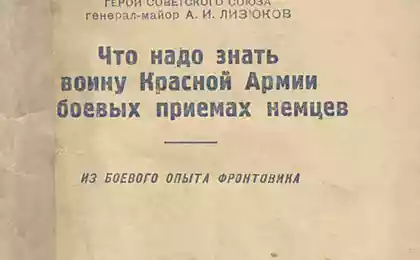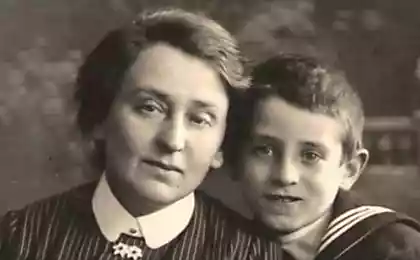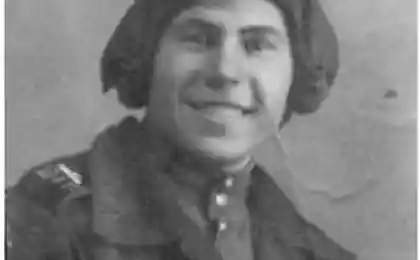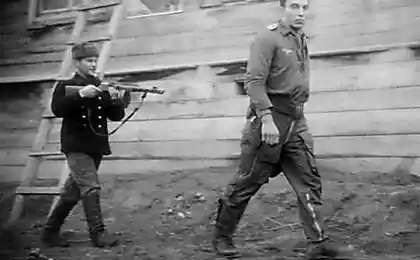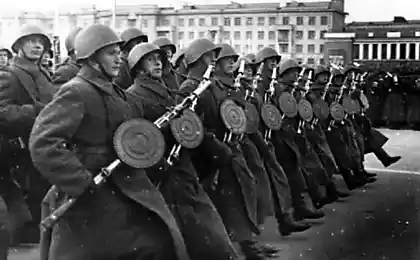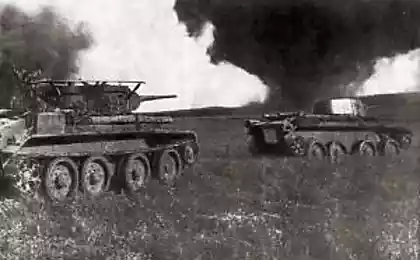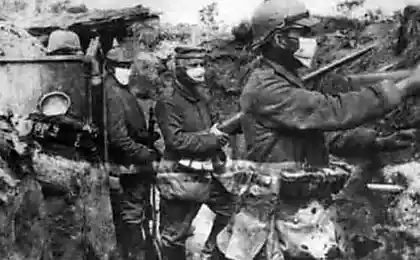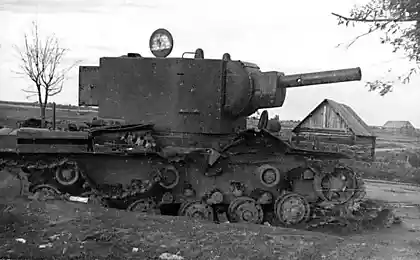769
"The Germans really do not like them ..."
In early August 1914 the First World War.
Millions army moved to the front.
The fighting qualities of weapons with which Russian soldiers fought in this war, there were ample: Russian rifle as both our arms, it satisfied its purpose and was no worse than most rifles of foreign armies. Accident on arms, sustained by the Russian army in the war, does not depend on the quality of weapons and on its quantity.
After a few months in the army was not enough rifles, artillery shells, hand grenades, and more.
But what to say, if an ordinary wire fell into the category of scarce materials ...
Photo: 1918. To hang grenade sample 1914 on a belt ring had to be moved to the bottom of the handle. In this position, the lever is released, the hammer is not cocked
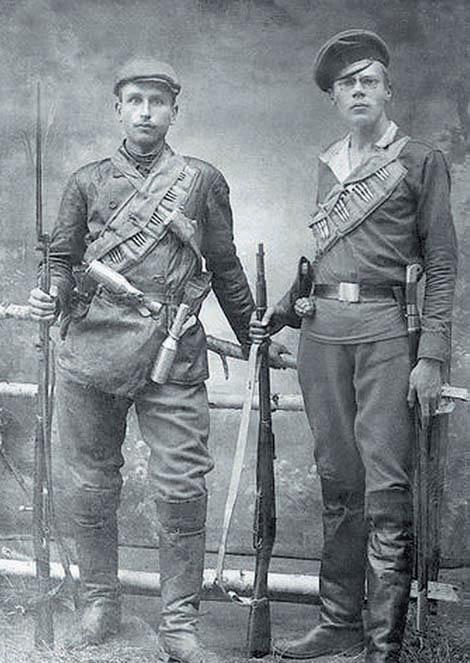
In 1908, the obligation to supply the army grenades were assigned to the Main Artillery Administration. All the documentation for the development GVTU grenade was given to the GAC. However, experts GAU differently imagined the trend of development of this type of weapon. If GVTU based on the experience of the last war favored concussion grenades, the specialists of the Main Artillery Directorate concluded that pomegranate remote action is preferable.
Developing remote grenades began in the years 1909-1910 artillery captain VI Rdultovskim.
VI Rdultovsky born in Vladikavkaz in 1867, graduated from the Voronezh Cadet Corps in 1893, the Mikhailovsky Artillery School in 1896, the Mikhailovsky Artillery Academy in 1902. The rank of captain was in the 3rd Reserve Artillery Brigade, engaged in the development of ammunition. After the revolution remained in Soviet Russia. Rdultov-sky developed a variety of ammunition from grenades to aerial bombs. In 1928 he received the title of "Honored Worker of Science" in 1933 was awarded the Order of the Red Star. He was the chief consultant of CDB-22, taught in military academies.
Grenade sample 1912

This grenade was designed Rdultovskim more in 1909 and the highest was approved in December 1910. Comparative tests of a new grenade grenade-on Lishi conducted in Ust-Izhora camps, showed her superiority in the following positions:
- Reliability of operation (all remote abandoned grenade exploded, while 70% of Lishin grenades thrown on swampy ground, given the refusal);
- Comparative compactness (due to its size and the shape of the new garnet was more convenient for throwing from a prone position and out of the trench);
- The safety of methane (small pieces grenades flying in the distance shorter range, so as to avoid damage thrower);
- Killability (garnet formed in the explosion about 1,000 fragments and create a zone around the site of the explosion of solid lesions);
It was marked by the following main drawback - the constant time delay that allows the opponent to drop a grenade.
In general, the Commission concluded that "... the pomegranate seems very cleverly designed and deserves the full attention ...».
In the description of a grenade stated: "... the grenade shell consists of a zinc box with a lid and the bottom, which is attached to a wooden handle, to one of the side walls of riveted lining covering the drummer with the mainspring and vtulochkoy fixedly fastened to the plate.
Explosive charge looks like a prism, with cut corners, made of pressed melinita and weighs 1 pound 4. The axis of the grenade, make an indentation into which the assembly is inserted into the grenade brass thimble. In the final gear grenades in this remote part of the thimble tube and the cap to 2, 5 grams of mercury fulminate.
The firing mechanism consists of a drummer with a handle, the mainspring, vtulochki motionless reinforced inside lining, checks and procrastination with the spring.
Ignition device consists of an aluminum tube glow of small capsule, bronze tube with a pressed composition and remote detonator capsule 2, 5 grams of mercury fulminate.
Grenade shrapnel grenades placed inside between the casing and the warhead, and consist of four zinc plates with cross cuts and zinc triangles (about 500 pieces) folded in bars and are located in the corners of the grenades ... ».
Vladimir I. Rdultovsky
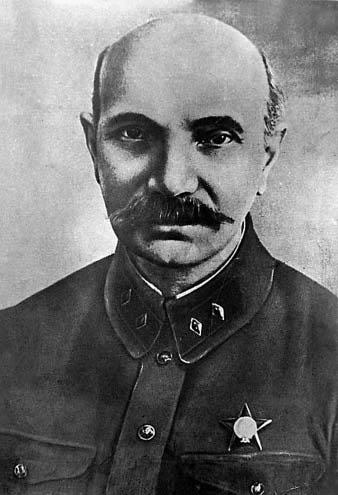
The body from the inside coated with shellac varnish.
To throw a grenade were taken in the right arm, so that the retaining ring is between thumb and pressed the lever grenades. Then the fuse taken aside, and then threw a grenade at a target.
At the time of the throw safety ring was in his hand. Guyed grenades cranks around its axis and drummer prick blasting fuse. After burnout zamedlitelnogo composition is an explosion of the detonator and the charge of the grenade.
Some of the difficulty in handling the grenade was a result of increased requirements for safety professionals GAU grenades. It was at the request of GAU design had two fuses. One - safety valve - moved away before throwing, the second - the ferrule - was removed at the time of the throw. It was stressed that at the time of the swing into a soldier gets shot, then a grenade would not explode, since the safety ring will remain on the handle. By the way, later we will see this trend continue in the future. RGD-33 will platoon at the time of the throw.
The explosion was formed around 1000 fragments: 500 ready to add to the approximately 300 fragments of arrays and about 200 from the body of the grenade. Grenade, produced during the test showed that: "... many of these fragments, pointing up into the land, lost, but still in the circle diameter of 9 yards, made up of targets in growth obtained from 150 to 400 through-holes in inch boards ... ".
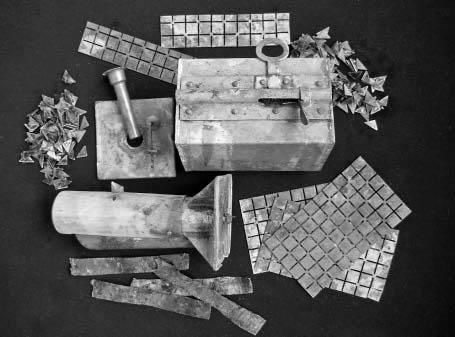
Manufacture of grenades was launched only in 1912 and that same year the first batch entered service their fortresses. The commanders of infantry and engineer units have repeatedly asked the leadership of the Chief Artillery Directorate send samples grenades for training officers and lower ranks. Chief Engineer's Office Asking artillery department of the possibility of supply of grenades in engineering units. In the journal of the meeting of the mobilization meeting of the Vilna Military District mentioned "... recognizes highly desirable to provide combat troops with hand grenades ...».
However, GAU a refusal in all cases. For example, a document from April 1912: "According to the notice of the Chief of the General Staff of the Office of the urgent need for the introduction of hand grenades in the table of field allowances of troops is not established. Notwithstanding that hand grenades made to supply them only fortress artillery ... ».
These hand-grenades as a whole proved to be a good side. These advantages include high-damaging effect (for example, by a grenade in 1912 sample punched inch
pine board at a distance of 1-3 fathoms, only the number of ready-made debris in the grenade is about 600 units), low cost and ease of manufacture. Veterans this grenade preferred other designs. Here's what one of them says: "... remote grenade stuffed with TNT Okhtenskoye Factory ... are favorite grenades scouts. It is proved that the Germans do not like them ... ».
German Memo with schemes and characteristics of Russian grenades sample of 1912 and 1914
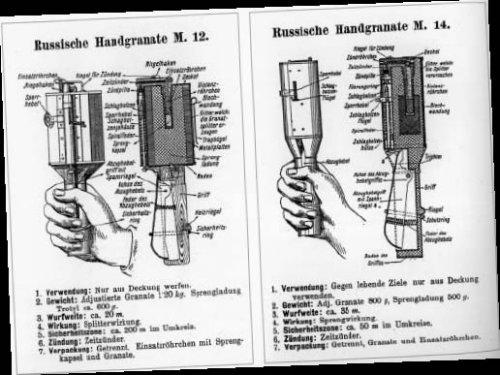
Grenades in 1914..
In the future, for the weapons of troops it has been developed and put into service in 1914. Grenade. Compared to the previous model it was lighter, more compact, it had a better shape.
Grenade body composed of tin, the explosive charge, fragmentation lattice nakolnogo mechanism and fuse.
Nakolny mechanism located in the tube body and like a grenade mechanism of the sample in 1912.
The case was filled with explosive grenades. As a full-time explosives to be used TNT and melinite. However, during the war it went and surrogate explosives based on ammonium nitrate. Grenades filled with these explosives, not inferior to the damaging properties of conventional grenades, but had a very serznye disadvantages associated with the chemical properties of ammonium nitrate. Soon after the arrival of these grenades to the front, it was observed that their body exposed to severe corrosion, and equipment can lose the explosive properties of the high hygroscopicity. To protect the "capricious" explosive from moisture had to pay more attention to tightness of the case more carefully propaivat body joints, that it was difficult and caused additional costs.
To store such grenades were required dry ventilated room, it was not always possible. Here are some excerpts from the documents of the time - 05/13/1916. Commander of 64 Infantry Kazan regiment brings the Chief of Staff 16 Division: "1916 May 9 day, we the undersigned, testified received 64 Infantry Kazan Regiment 3 Park 16 park Artillery Brigade coupons from 2 this May for the number 12, one thousand two hundred (1200) garnet sample 1914 And it turned out: seven hundred seventy grenades (770) is completely usable in combat, since most of them from careless storage pererzhavela spring arm, whereby the lever does not work and some pererzhavela latch, adhere to the capsule, and therefore faulty grenades, including seven hundred and seventy (770) shares shall be transferred back to the park 3, which decided to put on this act ».
In the story "School", which takes place in the civil war, A. Gaidar describes the use of hand grenades sample
1914 in a combat situation, "... you have a bomb? Nope? Take it from me alone. Wait, so it does not stick your butt in your pocket, you will become removed, the ring sdernesh. Sui fuse down ... ».
German Memo with schemes and characteristics of Russian grenades sample of 1912 and 1914
Or here's another: "... - Throw down a bomb! - I heard a short orders and saw in hand Chubuk flashed something and flew down. Dumb roar stunned me. - Throw! - I shouted Çubuk and immediately pulled my unit tunes and a hand grabbed my bomb and clicking fuse and threw it down.
- You fool! - He snapped me completely stunned and dumbfounded explosions rapid succession of unexpected hazards. - You fool! Ring took off and left guard ... ».
"... The bomb? - Çubuk smiled. -It, Brother, you're not alone, it is almost certainly wrong unused every throw, either fused or even without primer. When I was very young, just throwing. Oshaleesh, obaldeesh, so there is not something that fuse and ring and a sdёrnut Forget. So like as cobblestone run - and that is fine ... ».
Author Boris Pribylov

Source:
Millions army moved to the front.
The fighting qualities of weapons with which Russian soldiers fought in this war, there were ample: Russian rifle as both our arms, it satisfied its purpose and was no worse than most rifles of foreign armies. Accident on arms, sustained by the Russian army in the war, does not depend on the quality of weapons and on its quantity.
After a few months in the army was not enough rifles, artillery shells, hand grenades, and more.
But what to say, if an ordinary wire fell into the category of scarce materials ...
Photo: 1918. To hang grenade sample 1914 on a belt ring had to be moved to the bottom of the handle. In this position, the lever is released, the hammer is not cocked

In 1908, the obligation to supply the army grenades were assigned to the Main Artillery Administration. All the documentation for the development GVTU grenade was given to the GAC. However, experts GAU differently imagined the trend of development of this type of weapon. If GVTU based on the experience of the last war favored concussion grenades, the specialists of the Main Artillery Directorate concluded that pomegranate remote action is preferable.
Developing remote grenades began in the years 1909-1910 artillery captain VI Rdultovskim.
VI Rdultovsky born in Vladikavkaz in 1867, graduated from the Voronezh Cadet Corps in 1893, the Mikhailovsky Artillery School in 1896, the Mikhailovsky Artillery Academy in 1902. The rank of captain was in the 3rd Reserve Artillery Brigade, engaged in the development of ammunition. After the revolution remained in Soviet Russia. Rdultov-sky developed a variety of ammunition from grenades to aerial bombs. In 1928 he received the title of "Honored Worker of Science" in 1933 was awarded the Order of the Red Star. He was the chief consultant of CDB-22, taught in military academies.
Grenade sample 1912

This grenade was designed Rdultovskim more in 1909 and the highest was approved in December 1910. Comparative tests of a new grenade grenade-on Lishi conducted in Ust-Izhora camps, showed her superiority in the following positions:
- Reliability of operation (all remote abandoned grenade exploded, while 70% of Lishin grenades thrown on swampy ground, given the refusal);
- Comparative compactness (due to its size and the shape of the new garnet was more convenient for throwing from a prone position and out of the trench);
- The safety of methane (small pieces grenades flying in the distance shorter range, so as to avoid damage thrower);
- Killability (garnet formed in the explosion about 1,000 fragments and create a zone around the site of the explosion of solid lesions);
It was marked by the following main drawback - the constant time delay that allows the opponent to drop a grenade.
In general, the Commission concluded that "... the pomegranate seems very cleverly designed and deserves the full attention ...».
In the description of a grenade stated: "... the grenade shell consists of a zinc box with a lid and the bottom, which is attached to a wooden handle, to one of the side walls of riveted lining covering the drummer with the mainspring and vtulochkoy fixedly fastened to the plate.
Explosive charge looks like a prism, with cut corners, made of pressed melinita and weighs 1 pound 4. The axis of the grenade, make an indentation into which the assembly is inserted into the grenade brass thimble. In the final gear grenades in this remote part of the thimble tube and the cap to 2, 5 grams of mercury fulminate.
The firing mechanism consists of a drummer with a handle, the mainspring, vtulochki motionless reinforced inside lining, checks and procrastination with the spring.
Ignition device consists of an aluminum tube glow of small capsule, bronze tube with a pressed composition and remote detonator capsule 2, 5 grams of mercury fulminate.
Grenade shrapnel grenades placed inside between the casing and the warhead, and consist of four zinc plates with cross cuts and zinc triangles (about 500 pieces) folded in bars and are located in the corners of the grenades ... ».
Vladimir I. Rdultovsky

The body from the inside coated with shellac varnish.
To throw a grenade were taken in the right arm, so that the retaining ring is between thumb and pressed the lever grenades. Then the fuse taken aside, and then threw a grenade at a target.
At the time of the throw safety ring was in his hand. Guyed grenades cranks around its axis and drummer prick blasting fuse. After burnout zamedlitelnogo composition is an explosion of the detonator and the charge of the grenade.
Some of the difficulty in handling the grenade was a result of increased requirements for safety professionals GAU grenades. It was at the request of GAU design had two fuses. One - safety valve - moved away before throwing, the second - the ferrule - was removed at the time of the throw. It was stressed that at the time of the swing into a soldier gets shot, then a grenade would not explode, since the safety ring will remain on the handle. By the way, later we will see this trend continue in the future. RGD-33 will platoon at the time of the throw.
The explosion was formed around 1000 fragments: 500 ready to add to the approximately 300 fragments of arrays and about 200 from the body of the grenade. Grenade, produced during the test showed that: "... many of these fragments, pointing up into the land, lost, but still in the circle diameter of 9 yards, made up of targets in growth obtained from 150 to 400 through-holes in inch boards ... ".

Manufacture of grenades was launched only in 1912 and that same year the first batch entered service their fortresses. The commanders of infantry and engineer units have repeatedly asked the leadership of the Chief Artillery Directorate send samples grenades for training officers and lower ranks. Chief Engineer's Office Asking artillery department of the possibility of supply of grenades in engineering units. In the journal of the meeting of the mobilization meeting of the Vilna Military District mentioned "... recognizes highly desirable to provide combat troops with hand grenades ...».
However, GAU a refusal in all cases. For example, a document from April 1912: "According to the notice of the Chief of the General Staff of the Office of the urgent need for the introduction of hand grenades in the table of field allowances of troops is not established. Notwithstanding that hand grenades made to supply them only fortress artillery ... ».
These hand-grenades as a whole proved to be a good side. These advantages include high-damaging effect (for example, by a grenade in 1912 sample punched inch
pine board at a distance of 1-3 fathoms, only the number of ready-made debris in the grenade is about 600 units), low cost and ease of manufacture. Veterans this grenade preferred other designs. Here's what one of them says: "... remote grenade stuffed with TNT Okhtenskoye Factory ... are favorite grenades scouts. It is proved that the Germans do not like them ... ».
German Memo with schemes and characteristics of Russian grenades sample of 1912 and 1914

Grenades in 1914..
In the future, for the weapons of troops it has been developed and put into service in 1914. Grenade. Compared to the previous model it was lighter, more compact, it had a better shape.
Grenade body composed of tin, the explosive charge, fragmentation lattice nakolnogo mechanism and fuse.
Nakolny mechanism located in the tube body and like a grenade mechanism of the sample in 1912.
The case was filled with explosive grenades. As a full-time explosives to be used TNT and melinite. However, during the war it went and surrogate explosives based on ammonium nitrate. Grenades filled with these explosives, not inferior to the damaging properties of conventional grenades, but had a very serznye disadvantages associated with the chemical properties of ammonium nitrate. Soon after the arrival of these grenades to the front, it was observed that their body exposed to severe corrosion, and equipment can lose the explosive properties of the high hygroscopicity. To protect the "capricious" explosive from moisture had to pay more attention to tightness of the case more carefully propaivat body joints, that it was difficult and caused additional costs.
To store such grenades were required dry ventilated room, it was not always possible. Here are some excerpts from the documents of the time - 05/13/1916. Commander of 64 Infantry Kazan regiment brings the Chief of Staff 16 Division: "1916 May 9 day, we the undersigned, testified received 64 Infantry Kazan Regiment 3 Park 16 park Artillery Brigade coupons from 2 this May for the number 12, one thousand two hundred (1200) garnet sample 1914 And it turned out: seven hundred seventy grenades (770) is completely usable in combat, since most of them from careless storage pererzhavela spring arm, whereby the lever does not work and some pererzhavela latch, adhere to the capsule, and therefore faulty grenades, including seven hundred and seventy (770) shares shall be transferred back to the park 3, which decided to put on this act ».
In the story "School", which takes place in the civil war, A. Gaidar describes the use of hand grenades sample
1914 in a combat situation, "... you have a bomb? Nope? Take it from me alone. Wait, so it does not stick your butt in your pocket, you will become removed, the ring sdernesh. Sui fuse down ... ».
German Memo with schemes and characteristics of Russian grenades sample of 1912 and 1914
Or here's another: "... - Throw down a bomb! - I heard a short orders and saw in hand Chubuk flashed something and flew down. Dumb roar stunned me. - Throw! - I shouted Çubuk and immediately pulled my unit tunes and a hand grabbed my bomb and clicking fuse and threw it down.
- You fool! - He snapped me completely stunned and dumbfounded explosions rapid succession of unexpected hazards. - You fool! Ring took off and left guard ... ».
"... The bomb? - Çubuk smiled. -It, Brother, you're not alone, it is almost certainly wrong unused every throw, either fused or even without primer. When I was very young, just throwing. Oshaleesh, obaldeesh, so there is not something that fuse and ring and a sdёrnut Forget. So like as cobblestone run - and that is fine ... ».
Author Boris Pribylov

Source:
